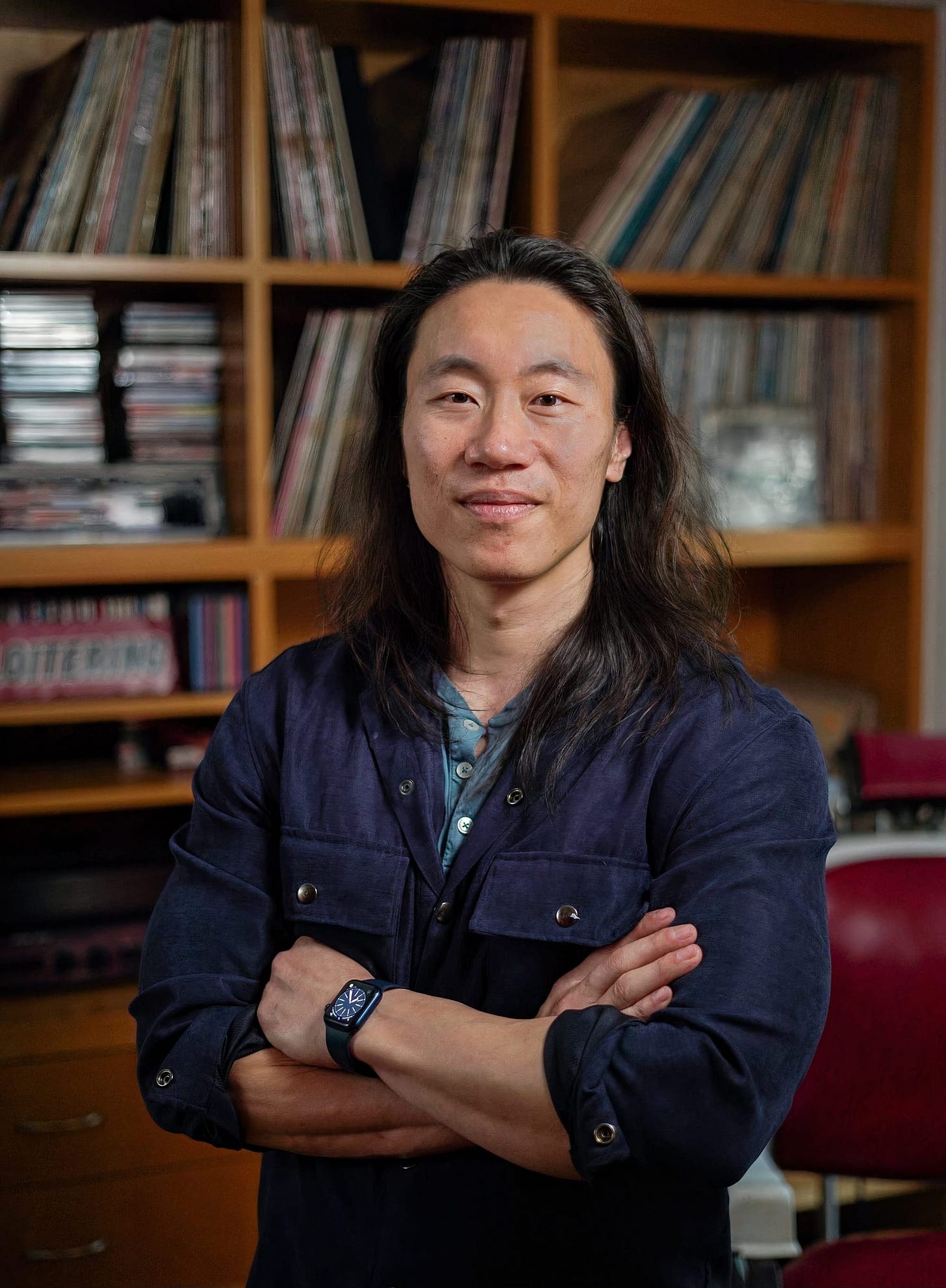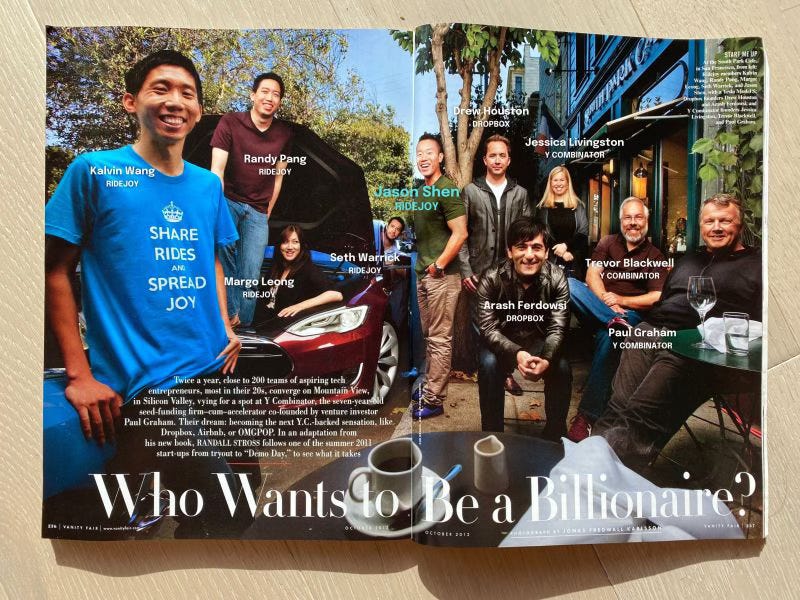The Placeholder Interview: Jason Shen
Jason's reflections on how he navigated ambiguity and vulnerability of his Placeholder with social support, courage, and resilience.
Jason Shen is a writer and executive coach. Helping out many startup founders as a coach is one of many experiments he has run so far. Previously, he founded three venture-backed startups & led product teams at Etsy and Meta. He is a Y Combinator alum (S11), and NCAA mens gymnastics national champion. You can tell he likes trying new stuff, but it’s not that he was born with it.
Jason and I met at Meta while we’re both in each of our own Placeholder phases, which we didn’t know back then 😂. In one of the courses I taught at Meta, he shared his experiences of failure with his startup Ride Joy. He and his cofounders were once features in the Vanity Fair as one of the rising startups of the Y-Combinator along with Dropbox cofounders and Paul Graham of the Y-Combinator. But in the month this Vanity Fair spread hit newsstands, his company was falling apart. Soon after this, they had to discontinue Ride Joy.
Closing the door of Ride Joy was painful but didn’t stop Jason from evolving. Through this evolution, he learned how to synthesize insights of himself, create the next new ideas for himself based on such insights, and experiment those ideas constantly. In a nutshell, Jason’s story embodies every Placeholder perspective so well that his story has become a part of the book, The Placeholder (Chapter 9).
In July 2025, he shared his further contemplations with me on how he sees the Placeholder, not just as an inflection point in career but as an adaptive way of being—across business, relationships, identity, and self-worth. Below is the six key points from this Placeholder Interview.
Six Placeholder Insights from Jason Shen
1. The Placeholder Is Not a One-Time Phase—It’s Ongoing and Multi-Dimensional
For Jason, the Placeholder is not a phase you are simply “in” or “out” of. It can exist in different areas of life simultaneously. He describes some stable phases of life and work, in which you might feel you are not in the Placeholder. Yet there are also more uncertain and exploratory phases, which coexist with the stable parts. His reflection points out that the Placeholder is not a pit stop but a continual practice of reinvention and responsiveness to change.
2. Is the Change Tolerance is a Skill or a Trait?
Are we born with change tolerance? Or can we learn to become better at it? While Jason acknowledges that openness to experience is partially temperamental, he stresses that the capacity to handle uncertainty grows through experience. And that’s how we build confidence - by doing, not just preparing.
“You can never build real confidence just through preparation… It’s only by going through change and not having everything figured out that you build the belief that you can handle it.”
This insight resonates so well with the third perspective of the Placeholder: a “Mad Scientist”—where experiments, rather than mastery, leads to forward motion.
3. Fear of Looking Wrong or Foolish: Why We Resist the Placeholder
Jason frames much of resistance to change as a fear of being wrong, not dumb. Many would rather be “right” in a safe but unfulfilling career than risk trying something new and possibly failing publicly.
“It’s not just fear of failure. It’s fear of looking like you failed.”
This fear makes the initial threshold into the Placeholder so high. It’s not just because of external risks, but because of internalized perfectionism and social conditioning.
4. Quitting is an Underrated Skill
Jason reframes quitting not as giving up but as “making space for what could be,” Using the film Up as a metaphor for letting go of the past to move forward, we can resonate with the difficulty and emotional complexity of quitting. Jason reflects on his startup failure with nuance—acknowledging how abrupt decisions, lack of emotional support, and discomfort with ambiguity made quitting harder than necessary.
“You quit a job, it doesn’t mean that you never had it… That was a period of time in your life and now you’re in a new period.”
The element of “quitting” is essential in the Placeholder. We get to truly have a mental and physical space and time for us to create the work truly meaningful to us only by letting go of what we used to work on. Yet this is often challenged by many cognitive biases such as loss aversion and sunk cost bias.
5. Being Seen During Change is a Vulnerable but Necessary Part of Growth
Many people want to change “in secret” and only re-emerge once they’ve succeeded. But true growth, Jason says, happens when others witness your uncertainty and still believe in you. Jason reflects on the failure of his startup and why it was hard to let others see him in an uncertain state.
“We want to disappear, transform, and then come back perfect. But the real trust is built when people see you evolving.”
The Placeholder is a communal experience; it’s never about individual ideation and success, but about holding space—for yourself and others—as messy and work-in-progress humans.
6. You Cannot Change Alone.
A lot of people misunderstand that the changes they are making through the Placeholder are solitary projects. It’s not. You can’t change alone. You need so much social support. Jason also points out that it’s not about how much social support you have but about the perception that there is social support for you, which keeps you going. He takes the endurance sports as an example. It’s so difficult you need someone who could help you with mental management of pain, expectations and holding you accountable for gradual progress.
Creating your own meaningful work in the Placeholder requires the same social support. You can seek out such supports from your friends, coworkers and mentors. Also, professional coaches exist to give you more structured and professional support from coaches. If you aren’t sure of what kind of supports you need the most, you can start with reading The Placeholder.
Hope you enjoyed watching these six great insights from Jason about the Placeholder. If you want to learn more about Jason and his work, visit the following links! ❤️



